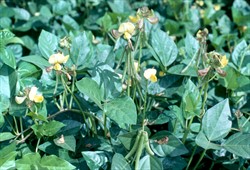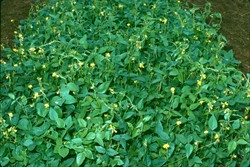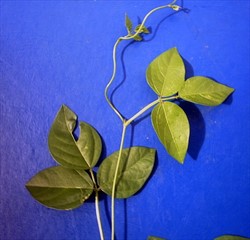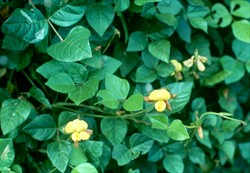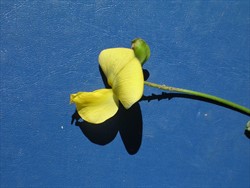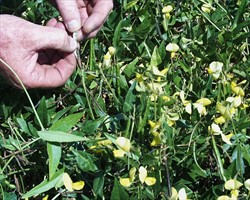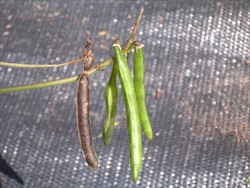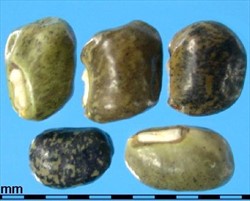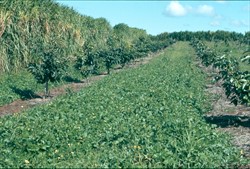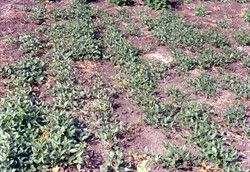Vigna luteola
Tropical Forages
Vigna luteola (Jacq.) Benth.
Basionym: Dolichos luteolus Jacq.; Dolichos niloticus Delile; Dolichos repens L.; Vigna glabra Savi; Vigna marina auct. Austral.; Vigna nilotica (Delile) Hook. f.; Vigna repens (L.) Kuntze
Family: Fabaceae (alt. Leguminosae) subfamily: Faboideae tribe: Phaseoleae subtribe: Phaseolinae subgenus: Vigna.
Annual or perennial herb, trailing to 10 m or climbing to 2.5 m; stems glabrous to densely hairy, rooting readily when in contact with moist soil. Leaves trifoliolate; leaflets ovate, ovate-elliptic, or ovate-lanceolate, rarely linear-lanceolate, 2.5–10 (–11) cm long, 0.4–5 cm wide, acute or acuminate at the apex, rounded or cuneate at the base, sparsely pubescent on both surfaces or glabrous, petiole 2–8 cm long; rachis 0.5–1.5 cm long; petiolules 2–3 mm long; stipules mostly linear-lanceolate (rarely ovate), 3–4 mm long, 2 mm wide, shortly bilobed at the base. Inflorescence an axillary raceme, few to many flowered, rachis 1.5–5.5 cm long, peduncles 5–40 cm long; pedicels 4–9 mm long. Calyx green, glabrescent to densely hairy; tube 2–4 mm long; lobes 1.5–4 mm long; the lower one almost twice as long as the others, the upper pair united into an acute, rounded and mucronate, or slightly bilobed lip. Flowers papilionate; standard yellow to greenish yellow (sometimes tinged red outside), 1.3–2.5 cm long, 1.2–2.6 cm wide. Pods pendant, linear, 4–8 cm long, 4–6.5 mm wide with slight constrictions between the 4–9 (–12) seeds; sparsely to rather densely adpressed pubescent with a short curved beak; green when young, ripening through yellow to dark brown, nearly black when ripe. Seeds dark red-brown or grey brown with black speckling to black, oblong or ovate-rhombic, 3–4.5 × 3–3.5 × 2–3 mm. 40,000 seeds per kg.
Similar species
V. luteola is sometimes confused with V. marina, both trailing vines with yellow flowers and found near water.
V. luteola: Found in grasslands, lake edges, riverbanks, swamp edges; leaflets acute or acuminate at apex; calyx tube 2–4 mm long, calyx lobes 1.5–4 mm long; standard 1.5–2.5 cm long; legumes pubescent, 4–8 cm long, 4–6.5 mm wide, containing 4–9 (–12) oblong or ovate-rhombic seeds.
V. marina: Found along seashores; leaflets rounded or obtuse, sometimes emarginate, at apex; calyx tube ca. 2.5 mm long, calyx lobes 1–1.5 mm long; standard ca. 1.2 cm long; legumes glabrous when ripe, 3.5–6 cm long, 7–9 mm wide, containing 2–6 almost globose seeds.
Africa: gilibande, goko, masheke, mugulula, indola a kwakwa, ka vuhivahi, kavuhivuhi, toshimboshimbo, umurakuku (Democratic Republic of the Congo); mare (Niger); kuanga (Thonga, southern Africa); akwari, lubiya taiyib (Sudan); kisukuna, kashilika (Tanzania)
Asia: 长叶豇豆 chang ye jiang dou (China); לוּבְיָה מִצְרִית, Nile bean והיא נפוצה מאוד (Hebrew); nagaba-hama-sasage (Japan)
Caribbean: pwa jòn, pwa zombi, pwa zonbi (St Lucia); caupi de monte (Netherlands Antilles); pois jaune, pois pigeon (Guadeloupe, Martinique); frijol cimarrón (Cuba); wild pea, goat wiss (Virgin Islands); frijol silvestre, frijol marrullero (Puerto Rico); monkey pea, rouncival, yellow zombie pea
English: Dalrymple vigna (Australia); sea bean (Belize); deer pea, hairy cowpea, hairy pod cowpea, yellow vigna (USA); wild vigna, Nile bean
Indian Ocean: antaka, famehifary, telouravy, vahipoko, vahisanjy (Madagascar)
Latin America: porotillo del agua, machagai, porotillo de los sapos, batatilla (Argentina); batarana, batatarana, feijão-da-praia, vigna (Brazil); frisol de vaca (Colombia); pois-zombie, pois pigeon, pois-jaune (French Guiana); frijol de playa (Honduras); frijol de monte (Mexico); frijol maravilla, porotillo, vigna amarilla (Spanish); bejuco marullero (Venezuela)
Native (exact native range obscure):
Africa: Angola; Benin; Botswana; Burundi; Cameroon; Chad; Côte d'Ivoire; Democratic Republic of the Congo; Egypt; Ethiopia; Equatorial Guinea; Gabon; Ghana; Guinea-Bissau; Kenya; Liberia; Malawi; Mozambique; Niger; Rwanda; Senegal; Sierra Leone; South Africa; Sudan; Tanzania; Togo; Uganda; Zambia; Zimbabwe
Asia: Bangladesh; India (West Bengal); Indonesia; Japan; Laos; Malaysia; Myanmar; Philippines; Sri Lanka; Taiwan; Thailand; Vietnam; Yemen
Australasia: Australia (New South Wales (n.e.), Northern Territory, Queensland); Papua New Guinea
North America: Mexico (Campeche, Chiapas, Guerrero, Jalisco, Morelos, Quintana Roo, Tabasco, Tamaulipas, Veracruz, Yucatán); USA (Alabama (s.), Florida, Georgia, Louisiana (s.), Mississippi (s.), North Carolina (s.e.), South Carolina, Texas (s.e.))
Caribbean: Antigua and Barbuda (Antigua); Barbados; Cuba; Dominica; Dominican Republic; Grenada; Guadeloupe; Haiti; Jamaica; Martinique; Netherlands Antilles; Puerto Rico; St. Kitts and Nevis (Nevis); St. Lucia; St. Vincent and The Grenadines (St. Vincent); Virgin Islands (British); Virgin Islands (U.S.)
Central America: Belize; Costa Rica; El Salvador; Guatemala; Honduras; Nicaragua; Panama
South America: Argentina (Buenos Aires, Corrientes, Entre Rios, Formosa, Misiones); Brazil; Colombia; Ecuador; French Guiana; Guyana; Peru; Suriname; Uruguay; Venezuela (n.)
Naturalized:
Throughout tropics & subtropics, and in e. Mediterranean region)
Cultivated:
Australasia: Australia (Queensland)
Forage
V. luteola is a productive and palatable species that can be used as a short-term (±3 years) legume in pasture, particularly in damp areas. It is one of the best legumes for wet conditions and one of the best pioneer plants in such situations.
Environment
It can be used as a green manure or ley cover crop in cropland, especially in seasonally wet sugarcane (Saccharum officinarum) areas. It could have a role in agroforestry, forming a good ground cover in shaded situations, although its twining habit may present problems with young trees.
Other
V. luteola flowers and seeds can be boiled and eaten as a vegetable, and the roots are dug up by children, peeled and chewed to extract a sweet juice. Various parts of the plant are used in folk medecine around the world, for treatment of conditions as diverse as boils, ulcers, syphilis, asthma, tumour and high cholesterol, and are also given to infants as a strengthener.
Soil requirements
V. luteola is adapted to a wide range of soils, from light loams to heavy textured clays, from very acid to strongly alkaline, and from non-saline to quite strongly saline soils.
Moisture
Prefers good soil moisture conditions, and is tolerant of waterlogging and short-term flooding. While it can make a useful contribution in areas with average rainfalls as low as 800 mm/yr, ideally rainfall should be >1,200 mm, and up to 4,000 mm or more. In lower rainfall environments, soils should have good moisture storage characteristics. It has little drought tolerance and is unproductive under dry conditions.
Temperature
V. luteola is found over a diverse range of temperature environments. While it mostly occurs at 650–2,150 m asl in tropical Africa, and has been found at 2,050 m asl (9°50' N) in Costa Rica, it is also recorded from more temperate environments such as Buenos Aires (34º S, Argentina) and New York (40° N, USA), and also from the lowland tropics of Central America. Average annual temperature in these areas spans about 13–26 °C. Optimum temperature for growth is in the range 20–30 °C. While the only cultivar, ‘Dalrymple’, is very susceptible to frost, there may be provenances with greater cold tolerance from higher latitudes.
Light
Although V. luteola has been shown to be relatively high yielding compared with a wide range of other legumes under moderate and dense shade environments (50% and 20% light transmission), other legumes such as Arachis pintoi, A. repens and Grona heterocarpa subsp. ovalifolia offer greater persistence. At 65% light transmission, even the more light-demanding species, Stylosanthes guianensis and S. scabra can give higher yields.
Reproductive development
Flowering time appears to vary with provenance. The photo-periodic requirement could well be confounded with moisture availability and/or a need for low temperatures. Most of a range of accessions tested in subtropical (28º S) Australia, flowered in early April, some 90 days after sowing, while natural stands at 26º N in the USA flower through much of the growing season. At lower latitudes, ‘Dalrymple’ flowered about 90 days after sowing at 15º S in northern Australia, and another accession, CPI 46383 at 17º S, commenced flowering only 50 days after planting (mid January), but produced peaks of flowering in late April and again in mid-July.
Defoliation
V. luteola is extremely palatable and is preferentially grazed. Although established plants are somewhat stoloniferous and can tolerate short periods of heavy grazing, recovery or spelling periods are an essential part of grazing management. Under more lenient grazing, it may persist for 3 years or longer.
Fire
V. luteola does not normally grow in fire-prone environments.
Guidelines for establishment and management of sown forages.
Establishment
V. luteola often has a high percentage of hard seed, and germination should be tested prior to use. If hard seed levels are greater than 50%, then seed should be scarified before sowing. It is not specific in its rhizobium requirements, but can be inoculated with cowpea strain (e.g. CB 756 in Australia) if there is any doubt. Seed is normally sown 2–3 cm deep, at 2 kg/ha when sown in mixtures and 5 kg/ha when sown alone. Sowing rates of 10–20 kg/ha are preferable when it is used as a green manure. It has a large seed and vigorous seedlings, and is easily established in well-prepared seed beds, competing well with weeds. It is also readily propagated from cuttings, particularly if the cutting pieces have already developed root primordia or roots.
Fertilizer
V. luteola requires at least moderate soil P, and may also respond to Mo in more acid soils. Additional S may be necessary in some soils.
Compatibility (with other species)
Compatible with most tussocky tropical grasses. Because of its twining growth habit, it may not be appropriate as a ground cover in plantation crops. Its most likely use is in short term pasture and green manure situations where compatibility is not critical.
Companion species
Grasses: Chloris gayana, Megathyrsus maximus, Paspalum plicatulum, Setaria sphacelata, Urochloa decumbens.
Legumes: Aeschynomene americana.
Pests and diseases
Like many Vigna species, V. luteola is susceptible to insect damage, particularly from caterpillars (e.g. Prodenia spp.) and jassids (Cicadellidae: Homoptera). There do not appear to be any major disease problems, although it is recorded as being susceptible to “witches’ broom” phytoplasma disease and is listed as a host of bean golden mosaic bigeminivirus and cowpea severe mosaic Comovirus in Brazil, and peanut mottle virus in Australia.
Ability to spread
Although there is the potential for spread through pod dehiscence and high seed yields, spread is usually restricted under grazing because of its high palatability. Further, it tends to grow over pods, burying them in foliage if not grazed, thus reducing dehiscence. It can be spread by seed in dung under favourable conditions of warmth and moisture, but not readily. V. luteola has hollow seeds which can float on the water, thus aiding dissemination.
Weed potential
It is considered a weed of rice in South America, and is on the national weed list in South Africa .
Nutritive value
17% protein has been recorded at flowering. P levels in the dry matter have been measured at 0.15% in low P soils and up to 0.34% at luxury P levels.
Palatability/acceptability
Extremely palatable and selectively grazed.
Toxicity
None recorded.
Dry matter
V. luteola has produced >4 t/ha DM when grown in a pure sward on clay soil under good growing conditions. In a comparison of a wide range of legumes in the humid subtropics of Australia, V. luteola was amongst the highest yielding species. Under shade in coconut plantations in Indonesia, annual yields ranged from 1 to 2.5 t/ha.
Animal production
No information available.
2n = 22; self-pollinating. While they are morphologically distinct, and do not seem to hybridize readily, Vigna luteola, V. marina and V. oblongifolia are so closely related they could almost be considered as conspecific. V. luteola is used as a source of resistance and improved nutritive value in cowpea breeding.
Vigna luteola seed is best produced in areas with a wet summer, followed by a dry season, although flowering is likely to be interrupted in frost-prone areas. The need for weed control is minimal due to rapid crop development and canopy closure, although use of pre-emergence herbicides may still help ensure a “clean” crop. Crops establish rapidly under irrigation and with warm soil conditions (±24 ºC at 10 cm depth) with canopy closure achieved about 4 weeks after sowing. Inflorescences tend to be overgrown by the canopy, particularly when produced early in the season, so pods often mature within the canopy. Crops need to be sprayed from flowering to minimise insect damage. Few pods set on racemes formed in the canopy. The crop reaches a height of about 30 cm. Owing to its indeterminate flowering habit, seed harvest is difficult. Exposed pods shatter, but not as readily as those of Macroptilium atropurpureum. Care is required during threshing to avoid damage to the seed. For mechanical harvesting, high capacity combine harvesters are required to manipulate the bulk of leafy material. This could be aided by chemically desiccating the crop prior to harvest. Hand-harvesting is best done in the morning before pods start to dry to avoid seed loss from pod-shatter. Pods can be picked at the yellow stage when seed is fully formed but still soft, then dried in the sun.
Imazethapyr can be used as pre-sowing/pre-emergent, post-sowing/pre-emergent or post-emergent herbicide (first or second trifoliolate leaf). Pre-emergent application may have some effect on germination and post-emergent application may have some slight effect on seedlings, although this is often short-term. Metolachlor and trifluralin can also be used as pre-emergent applications, but not atrazine or metribuzin. Acifluorfen, bentazone and flumetsulam appear safe as post-emergent sprays, but not 2,4-D, 2,4-DB, picloram, fluroxypur (fluroxypyr), or chlorsulfuron. Glyphosate can be used post- sowing/pre-emergent to control weeds at planting; it has also been used at low application rate on mature plants to control emerging weeds.
- Adapted to a wide range of soils.
- Tolerant of waterlogging.
- Easily established.
- Very palatable.
- Non bloating.
- Not tolerant of continuous grazing.
- Susceptible to insect and virus damage.
- Less drought tolerant than many other legumes.
- Rather short lived.
- Susceptible to frost.
Andrew, C.S. and Robins, M.F. (1969) The effect of phosphorus on the growth and chemical composition of some tropical pasture legumes. I. Growth and critical percentages of phosphorus. Australian Journal of Agricultural Research 20:665–674. https://doi.org/10.1071/AR9690665
Barnard, C. (1969) Herbage Plant Species. CSIRO Division of Plant Industry, Canberra, Australia.
Bogdan, A.V. (1977) Tropical Pasture and Fodder Plants. Longman Inc., New York, USA. p. 420–421.
Gillett, J.B., Polhill, R.M. and Verdcourt, B. (1971) Papilionoideae (Part 2). In: Milne-Redhead, E. and Polhill, R.M. (eds) Flora of Tropical East Africa. Crown Agents for Overseas Governments and Administrations, London, UK. p. 625–626.
Hacker, J.B., Williams, R.J. and Pengelly, B.C. (1996) A characterisation study of the genus Vigna with regards to potential as forage. Genetic Resources Communication No. 22. CSIRO Tropical Agriculture, St Lucia, Australia. bit.ly/39GfIIi
Kaligas, D.A. and Sumolang, C. (1991) Forages species for coconut plantations in North Sulawesi. In: Shelton, H.M. and Stür, W.W. (eds) Forages for Plantation Crops. Proceedings of a workshop, Sanur Beach, Bali, Indonesia. 27–29 June 1990. ACIAR Proceedings No. 32. Australian Centre for International Agricultural Research (ACIAR), Canberra, Australia. aciar.gov.au/node/8081
Ng, K.F., Stür, W.W. and Shelton, H.M. (1997) New forage species for integration of sheep in rubber plantations. The Journal of Agricultural Science 128:347–356. doi.org/10.1017/s0021859696004248
Pott, A. (2016) Vigna luteola (Feijão-da-praia). In: Vieira, R.F., Camillo, J. and Coradin, L. (eds) Espécies Nativas da Flora Brasileira de Valor Econômico Atual ou Potencial: Plantas para o Futuro ‒ Região Centro-Oeste. Secretaria de Biodiversidade, Ministério do Meio Ambiente, Brasília, DF, Brazil. p. 579‒584. https://bit.ly/2UMZUzo
Rika, I.K., Mendra, I.K, Oka Nurjaya, M.G. and Gusti Oka, M. (1991) New forage species for coconut plantations in Bali. In: Shelton, H.M. and Stür, W.W. (eds) Forages for Plantation Crops. Proceedings of a workshop, Sanur Beach, Bali, Indonesia. 27–29 June 1990. ACIAR Proceedings No. 32. Australian Centre for International Agricultural Research (ACIAR), Canberra, Australia. aciar.gov.au/node/8081
Skerman, P.J. (1977) Tropical forage legumes. FAO Plant Production and Protection Series No. 2. Food and Agriculture Organization of the United Nations (FAO), Rome, Italy. doc1.bibliothek.li/aay/FLMA174882.pdf
Stür, W.W. (1991) Screening forage species for shade tolerance – a preliminary report. In: Shelton, H.M. and Stür, W.W. (eds) Forages for Plantation Crops. Proceedings of a workshop, Sanur Beach, Bali, Indonesia. 27–29 June 1990. ACIAR Proceedings No. 32. Australian Centre for International Agricultural Research (ACIAR), Canberra, Australia. aciar.gov.au/node/8081
Verdcourt, B. 1979. A Manual of New Guinea Legumes. Office of Forests, Lae, Papua New Guinea.
‘Dalrymple’ (CPI 21347) Released in Australia (1965). Introduced from Instituto Interamericano de Ciencias Agricolas, Turrialba, Costa Rica, as Vigna marina. It is the only accession that has been widely tested. ‘Dalrymple’ was initially released as a forage for the wet tropics, but has subsequently shown potential as a green manure in this and less tropical, even sub-humid environments.
CPI 60428 Selected in Australia. Origin Mpugwe, Uganda (0.14° S, 1,061 m asl, 1,050 mm rainfall). Observed to have some jassid resistance in humid, subtropical Australia.
